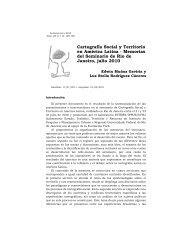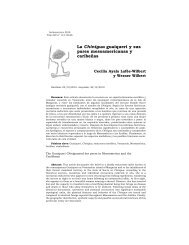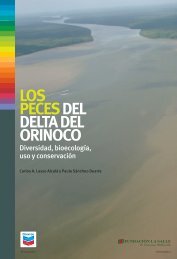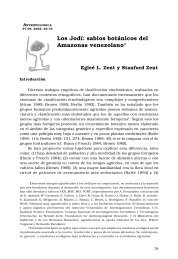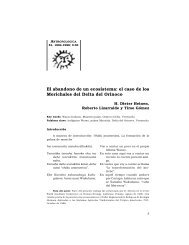War and a Semblance of Peace in the Inca Heartland
War and a Semblance of Peace in the Inca Heartland
War and a Semblance of Peace in the Inca Heartland
Create successful ePaper yourself
Turn your PDF publications into a flip-book with our unique Google optimized e-Paper software.
embassy. What happened is that <strong>the</strong> <strong>Inca</strong> gave his great-gr<strong>and</strong>fa<strong>the</strong>r some<br />
“ornately-decorated shirts <strong>and</strong> cloaks, <strong>and</strong> <strong>the</strong> k<strong>in</strong>d <strong>of</strong> cups <strong>the</strong>y dr<strong>in</strong>k from<br />
called aquillas”. The term aquilla refers to a cup made <strong>of</strong> precious metal, <strong>and</strong><br />
without <strong>the</strong> qualifier qori (gold), to a silver cup (González Holguín 1952: 689).<br />
Those who were hid<strong>in</strong>g first thought <strong>the</strong> <strong>Inca</strong> was com<strong>in</strong>g to kill <strong>the</strong>m when<br />
<strong>the</strong>y saw <strong>the</strong> embassy return, but rejoiced when <strong>the</strong>y recognized <strong>the</strong>ir own<br />
leaders. Capoguala led his people to where <strong>the</strong> <strong>Inca</strong> was <strong>and</strong> <strong>the</strong>y swore <strong>the</strong>ir<br />
obedience to him. From this group, Thupa <strong>Inca</strong> recruited an army to cont<strong>in</strong>ue<br />
north with him to Ecuador (ff. 19v-20). Pomaguala noted that o<strong>the</strong>rs who had<br />
not submitted to <strong>Inca</strong> authority had been defeated <strong>in</strong> battle, or had been tied<br />
up <strong>and</strong> <strong>the</strong>ir l<strong>and</strong>s taken from <strong>the</strong>m (at<strong>and</strong>o a algunos e tom<strong>and</strong>oles sus<br />
tierras) (ff. 19v-20).<br />
What is <strong>in</strong>terest<strong>in</strong>g to note is that <strong>the</strong> <strong>Inca</strong>s chose a fortified site as a<br />
negotiat<strong>in</strong>g po<strong>in</strong>t. This choice seems to <strong>in</strong>dicate that <strong>the</strong> <strong>Inca</strong>s <strong>of</strong>fered <strong>the</strong><br />
people a choice between submission or attack<strong>in</strong>g a fortified position. This was<br />
not much <strong>of</strong> a choice, but <strong>the</strong>n, <strong>the</strong> <strong>Inca</strong>s could not afford to lose. If <strong>the</strong>y did,<br />
<strong>the</strong> loss was pro<strong>of</strong> that <strong>the</strong>y were not quipo. One witness, Don Roldan Matara,<br />
a cacique from Cotabambas (southwest <strong>of</strong> Cuzco) gave <strong>the</strong> usual statement to<br />
<strong>the</strong> effect that those who did not peacefully submit <strong>and</strong> chose to defend<br />
<strong>the</strong>mselves were killed <strong>and</strong> treated with great cruelty. He added that some<br />
peoples submitted because <strong>the</strong>y were afraid <strong>of</strong> what would happen if <strong>the</strong>y did<br />
not, but also because <strong>the</strong> <strong>Inca</strong> said “he was son <strong>of</strong> <strong>the</strong> sun” (f. 65). Like Don<br />
Felipe Poma Macao, he noted that those who submitted “went with <strong>the</strong> <strong>Inca</strong>,<br />
help<strong>in</strong>g him to conquer <strong>and</strong> annex <strong>the</strong>se l<strong>and</strong>s” (f. 65).<br />
The Informaciones: Spanish Witnesses on <strong>Inca</strong> <strong>War</strong>fare<br />
The Spaniards <strong>in</strong>terviewed by Toledo did not have much to say about <strong>the</strong><br />
<strong>Inca</strong> expansion except <strong>in</strong> very general terms. What <strong>the</strong>y did remember were<br />
<strong>the</strong> gruesome details: visual memories <strong>of</strong> <strong>the</strong> bodies <strong>and</strong> body parts <strong>of</strong> <strong>Inca</strong><br />
enemies that were still to be seen <strong>in</strong> <strong>Inca</strong> possession or on <strong>the</strong> l<strong>and</strong>scape. For<br />
example, Juan de Pancorvo, one <strong>of</strong> <strong>the</strong> Spaniards who arrived <strong>in</strong> Cuzco with<br />
Francisco Pizarro, remembered a hillside about a day away from Cuzco where<br />
Atahuallpa’s general Challcochima had left some 50 to 100 duhos (small<br />
benches on which lords sat). The display symbolized all <strong>of</strong> <strong>the</strong> lords<br />
Challcochima had killed (f. 129v).<br />
The person who had seen <strong>the</strong> most was Alonso de Mesa, who had also<br />
come with Pizarro. While he had been <strong>in</strong> Cajamarca, ten or twelve caciques<br />
from Chachapoyas had been brought to Atahuallpa <strong>the</strong>re. Atahuallpa had<br />
<strong>the</strong>m taken to a corral <strong>and</strong> had <strong>the</strong>m killed by blows to <strong>the</strong> head with stones.<br />
Mesa also remembered see<strong>in</strong>g human drums:<br />
When <strong>the</strong>y took capta<strong>in</strong>s or c<strong>in</strong>checonas who had dist<strong>in</strong>guished<br />
<strong>the</strong>mselves <strong>in</strong> battle or <strong>in</strong>dividuals <strong>the</strong> <strong>Inca</strong> suspected might want<br />
to rebel, <strong>the</strong>y were killed. Leav<strong>in</strong>g <strong>the</strong> arms <strong>and</strong> <strong>the</strong> head whole,<br />
213



